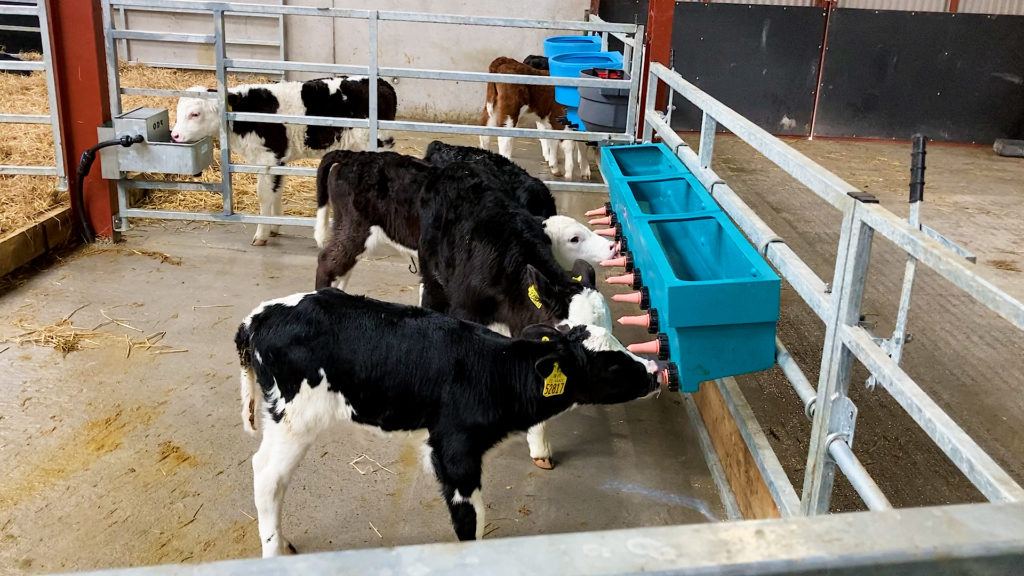The heifer of today will be the cow of tomorrow, but the considerable time lag between birth and first calving, makes it difficult for some dairy farmers to recognize the impact of their rearing and replacement strategies at both a cow and farm level – this is according to a recent report by Animal Health Ireland (AHI).
An efficient heifer-rearing system is crucial as it determines the future income and sustainability of a dairy enterprise.
Following feeding costs, heifer rearing is the second largest expense to the dairy system, accounting for 20% of total costs.
Calving replacement dairy heifers at 24 months-old is a necessity, in order to obtain maximum lifetime productivity – particularly in seasonal calving pasture-based systems like those that predominate in Ireland.
Calf nutrition in the pre-weaning period needs to be a careful balance of achieving adequate growth rates, while balancing milk intake with rumen development to get the calf weaned successfully.
The development of the rumen is important to ensure a smooth transition from milk feeding, to an adult diet at weaning, without setbacks in growth rates or digestive upsets.
Feeding the heifer calf
According to AHI, under-feeding dairy calves or using restricted feeding regimes will result in the calf failing to reach its potential growth target at key times during its life, while very high milk feeding or ad-lib feeding can reduce concentrate intake, which could delay rumen development and thus, weaning.
Feeding milk, or good-quality milk replacer at a rate of 13% to 15% of the calf’s birth weight per day, is considered optimal to ensure the correct balance of both milk and concentrate intake.
European (EU) law states that young calves need two milk feeds per day until their digestive systems have developed properly at four weeks-old.
Healthy calves may be fed milk once a day from four weeks onwards, and these calves will increase their intake of concentrates to make-up for the lack of milk.

Weaning
The time of weaning is somewhat dependent on the feeding regime. AHI stated that calves can be weaned once they are eating 1kg of concentrates per day for three or more consecutive days, which is usually from about eight to 10 weeks-old. However, if starter concentrates are limited or if larger volumes of liquid feed are given, this can be delayed.
To reduce stress, and the potential for a growth check at weaning, weaning should be done gradually. This is achieved by reducing the volume of milk the calves are fed over a 10 day period.
If calves are being fed manually more than once a day, the first move is to change to once a day feeding.
This is best to do approximately one month prior to weaning, to allow calves time to adjust to the new regime, and further develop their rumen prior to reducing the total amount of liquid given.
With automatic feeding systems calves tend to be fed larger volumes of liquid feed. Therefore, weaning should be as gradual as possible over the period of approximately four weeks.
In automatic calf feeding systems, the volume reduction is calculated by the computer programme on the feeder by using a milk feeding curve and adjusting accordingly.

Post weaning
The aim when rearing replacement dairy heifers is to ensure there is minimal difference between the lightest and the heaviest heifers in the group.
Average weight figures are not very informative as they hide the range in weights within the herd. Ideally calves should be weighed regularly to monitor weight gains.
If we do not measure, we can’t monitor their performance and intervene if required. Growth setbacks can occur at certain stressful stages, such as dehorning or weaning, so it is important to manage these events well, and keep stress to a minimum.
Stressful events should not occur together, disbudding or group changes for example, should not occur at weaning. Smaller calves should be given preferential treatment (higher quality grass, concentrate) throughout the summer months of their first grazing season.
Monitoring growth rates may seem like a tedious job, but it is worth it in the long run. There are several different targets to aim for to achieve the ideal age of first calving of 24 months.
These targets include:
- 30% of their adult body weight by 6 months-of-age.
- 60% of their adult body weight at bulling (15 months).
- 90% of adult body weight when they first calve at 24 months.
